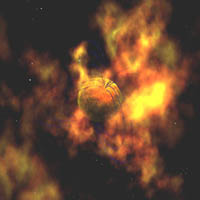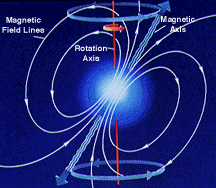Magnetars: Special Stars With That Attractive Charm

Magnetars are the superheroes of the star world, endowed with a colossal magnetic field strength that has baffled scientists for years. They are well over a trillion times more magnetic that the Sun and Earth. In the past ten years magnetars have graduated from the realm of speculation to near certainty.
Only about a dozen magnetars have been discovered so far. These appear to be a special breed of neutron stars, which themselves are well known for their strong magnetic fields.
How common are magnetars, and how did they gain their super magnetic strength? These are the key questions facing astronomers today. But finding evidence of their existence over the years has been nothing short of clever detective work.
Cosmic Dynamos ...
The story begins in 1979, in retrospect the year of the magnetar. Scientists discovered a strange object in January of that year that flashed lower-energy gamma rays and then grew dim again. Two months later, on March 5, one of the brightest gamma-ray events in the sky took place. The initial burst lasted only 0.2 seconds, but had as much energy as the Sun emits in 1000 years. In addition, it's intensity continued for 100 seconds, and was modulated with an 8-second period. A third such type object (though not as bright) appeared soon thereafter. At the time there was no way to distinguish these flashes from yet another cosmic mystery, gamma-ray bursts. These three new objects would flash brilliantly several times for up to a week, then shut off for months or years. It wasn't until about 1986 that scientists realized they had a unique kind of object on their hands. The outbursts were random, but unlike gamma-ray bursts, these were repetitive.
Being the type not to mince words, scientists called the objects Soft Gamma-ray Repeaters, or SGRs, where "soft" refers to lower-energy gamma rays, as opposed to the higher-energy "hard" kind. Uncovering the nature of these objects wasn't easy. They were dim if not undetectable most of the time between random outbursts. When they did light up, though, they were far brighter than an ordinary star. This is when they revealed a few secrets.
A New Spin on an Old Star ...

A smart bet was that SGRs were neutron stars because of the sheer energy released from such a compact region. The neutron star scenario made sense. During outbursts scientists could measure how fast the objects were spinning (the spin rate) and how fast they were slowing down (the spin-down rate). The ratio of the two rates serves as an estimate of magnetic field strength. This is because magnetic fields are thought to act as brakes, slowing the neutron star spin. A higher magnetic field implies a faster spin-down rate.
Estimates from the March 5, 1979 event indicated that SGRs had magnetic fields ranging from 100 trillion to a quadrillion (1015) gauss. Theorists began to speculate on what forces or conditions were needed to produce such a strong magnetic field. Two theorists, Robert Duncan (University of Texas, Austin) and Christopher Thompson (University of Toronto), proposed that newborn neutron stars could possess magnetic fields greater than a quadrillion gauss. This was the maximum efficiency for a neutron star dynamo. Most were not this efficient, but SGRs resulted from the explosion of a rapidly rotating star. Duncan and Thompson coined the term magnetar in a 1992 paper.
Observations by the Rossi X-ray Timing Explorer in the mid- and late 1990s confirmed this scenario, firmly identifying SGRs with neutron stars and making measurements of the spin and spin-down rate.
It was a mere cosmic coincidence that the first three SGRs were discovered only months apart in 1979. A fourth SGR wasn't discovered until 1998. Scientists had a working theory, but SGR magnetars were still a major mystery.
A Family Reunion ...
Meanwhile, through the 1980s and 1990s, another strange class of neutron stars were appearing, dubbed Anomalous X-ray Pulsars (AXPs) because of their X-ray intensity was greater than what could be attributed to by the spin-down energy. It was thought that the X-ray emission was powered by a strong magnetc field. The hard X-rays were close to the energy of the soft gamma rays of SGRs. You may have guessed where this is going. In 2002, Vicky Kapsi (McGill University) and her colleagues clinched the connection between AXPs and SGRs by finding SGR-like bursts in several AXPs. They were both magnetars, and this doubled the known number to ten... or maybe 12, depending on whom you ask.
Still, the magnetic field strengths were calculated by the spin versus spin-down method. Later in 2002, scientists using NASA's Rossi X-ray Timing Explorer captured a key measurement from SGR 1806-20, the fourth one discovered. Tod Strohmayer and Alaa Ibrahim (NASA Goddard) found a line in the spectrum of SGR 1806-20 that was at an energy of 5 keV. This is the consistent with the energy of a proton in a magnetic field of a quadrillion gauss.
This is the first direct measurement of a magnetar's magnetic strength, but it doesn't clinch the case. Strohmayer and Ibrahim can only assume that a proton is exhibiting this spectral line. But there is a small chance this could be an electron, which would imply a magnetic strength a thousand times lower.
Another Turn On ...
In 2003 Ibrahim made a chance discovery of a new magnetar while studying a known one. Combing through archived RXTE data, Craig Markwardt (Univ. Md & NASA/GSFC) found that this object was a very dim neutron star only months before. Vicki Kaspi confirmed the transient nature while studying a nearby source. The discovery suggests that neutron stars can go through a brief magnetar stage.
This magnetar must have "turned on" between January and March of 2003. One theory suggests that about ten percent of neutron stars are endowed with an ultrahigh magnetic field at birth, perhaps due to its initial spin, unique conditions in the implosion that created it, or the mass of the progenitor star. At first, these isolated neutron stars are too dim to study. In time, the magnetic fields act to slow the star's spin. This act of slowing releases energy, making the star brighter. Additional disturbances in the star's magnetic field and crust can make it brighter yet, causing it to flare, leading to the measurement of its magnetic field (a measure of its spin and the rate in which it is slowing).
Then the magnetic fields weaken, making the star perpetually dim. The magnetar stage may be but a brief moment of beauty in the billion-year existence of special neutron star. This would explain why scientists have only about a dozen magnetars so far. There could be many more out there simply in prolonged dim stages.
Like a superhero, only time will reveal their secret identity.
10th Anniversary Articles
Additional Links
As part of the series, we also published a number of retrospectives on Imagine the Universe!
Publication Date: June 2006


